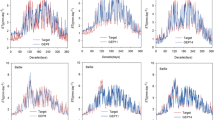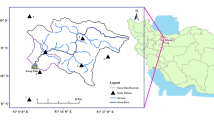Abstract
Recorded time series of relative humidity (RH) are modeled by using genetic expression programming (GEP) and artificial neural networks (ANNs) models. The data are noisy and contain missing datapoints. RH is modeled as a function of three meteorological variables: temperature, wind speed, and pressure. Various model structures of both of these models are investigated with the aim of testing the robustness of the predicted values in the presence of noise and missing data. Due to the presence of noise, a sophisticated treatment of missing data was not justifiable, and therefore, the strategy adopted was just to carry the datapoints backward, although this may induce bias in the time dimension and contaminate the predicted results. The results of this study indicate that through a careful selection of model structures both GEP and ANN can produce adequately reliable prediction of RH values 1 year into the future. The paper provides evidence that this model structure is feasible when the dependent variables include both the present and past values.





Similar content being viewed by others
References
Bertini I, Ceravolo F, Citterio M, Felice MD, Pietra BD, Margiotta F, Pizzuti S, Puglisi G (2010) Ambient temperature modeling with soft computing techniques. Sol Energy 84(7):1264–1272
Ciprian R, Lehman B (2009) Modeling effects of relative humidity, moisture, and extreme environmental conditions on power electronic performance. In: Energy conversion congress and exposition, 20–24 Sept, pp 1052–1059
Cruz RG, Miranda RC, Escalante JJG, Cruz ILL, Herrera AL, Rosa JI (2009) Calibration of a greenhouse climate model using evolutionary algorithms. Biosyst Eng 104(1):135–142
Dombayci OA, Golcu M (2009) Daily means ambient temperature prediction using artificial neural network method: a case study of Turkey. Renewable Energy 34(4):1158–1161
El-shafie A, Noureldim AE, Taha MR, Basri H (2008) Neural network model for Nile River inflow forecasting analysis of historical inflow data. J Appl Sci 8(24):4487–4499
Fabry F, Frush C, Zawadzki I, Kilmbi A (1997) On the extraction of near-surface index of refraction using radar phase measurements from ground targets. J Atmos Oceanic Technol 14:978–987
Ferreira C (2001a) Gene expression programming in problem solving. In: 6th Online world conference on soft computing in industrial applications (invited tutorial)
Ferreira C (2001) Gene expression programming: a new adaptive algorithm for solving problems. Complex Syst 13(2):87–129
Fogel LJ, Owens AJ, Walsh MJ (1966) Artificial Intelligence through simulated evolution. Wiley, New York
Ghorbani MA, Khatibi R, Aytek A, Makarynskyy O, Shiri J (2010) Sea water level forecasting using genetic programming and comparing the performance with artificial neural networks. Comput Geosci 36(5):620–627
Guven A, Kisi O (2011) Daily pan evaporation modeling using linear genetic programming technique. Irrig Sci 29(2):135–145
Haykin S (1998) Neural networks: a comprehensive foundation, 2nd edn. Prentice Hall, Englewood Cliffs
Holland JH (1975) Adaptation in natural and artificial systems. University of Michigan press, MI
Honaker J, King G (2010) What to do about missing values in time series cross-section data. Am J Pol Sci 54(3):561–581
Huo Z, Feng S, Kang S, Dai X (2012) Artificial neural network models for reference evapotranspiration in an arid area of northwest China. J Arid Environ 82:81–90
Kaur A, Sharma JK, Agrawal S (2011) Artificial neural networks in forecasting maximum and minimum relative humidity. Int J Comput Sci Netw Secur 11(5):197–199
Khatibi R, Ghorbani MA, Aalami MT, Kocak K, Makarynskyy O, Makarynska D, Aalinezhad D (2011) Dynamics of hourly sea level at Hillary Boat Harbour, Western Australia: a chaos theory perspective. J Ocean Dyn 61(11):1797–1807
Khatibi R, Ghorbani M, Hesenpur MK, Kişi Ö (2011) Comparison of three artificial intelligence techniques for discharge routing. J Hydrol 403(3–4):201–212
Khatibi R, Ghorbani MA, Asadi H, Yousefi P (2012) Inter-comparison of an evolutionary programming model of suspended sediment time-series with other local models. In: Soto SV (ed) Genetic programming. InTech Open Access Publisher, ISBN 980-953-307-215-4, http://www.intechopen.com (in press)
Koza JR (1992) Genetic programming: on the programming of computers by means of natural selection. The MIT Press, Cambridge
Kretzschmar R, Eckert P, Cattani D, Eggiman F (2004) Neural network classifiers for local wind prediction. J Appl Meteorol 43(5):727–738
Lu T, Viljanen M (2009) Prediction of indoor temperature and relative humidity using neural network models: model comparison. Neural Comput Appl 18(4):345–357
Maier HR, Jain A, Dandy GC, Sudheer KP (2010) Methods used for the development of neural networks for the prediction of water resource variables in river systems: current status and future directions. Environ Modell Softw 25(8):891–909
Matyasovszky I (2001) A nonlinear approach to modelling climatological time series. Theor Appl Climatol 69(3–4):139–147
Mellit A, Drif M, Malek A (2010) EPNN-based prediction of meteorological data for renewable energy systems. Rev Renewable Energy 13(1):25–47
Mitchell F (1977) Practical weather forecasting. Woodbury, New York
Paras S, Mathur S, Kumar A, Chandra M (2007) A feature based neural network model for weather forecasting. In processing of world Academy of science, engineering and technology. pp 66–73
Rogers RR, Yau MK (1989) A short course in cloud physics. Pergamon Press, Oxford, p 293
Samer S, Tamer K (2012) Modeling of relative humidity using artificial neural network. J Asian Sci Res 2(2):81–86
Shuichi H, Mamoru M, Toshikazu I (1990) Statistical time series models of solar radiation and outdoor temperature-identification of seasonal models by Kalman filter. Energy Buildings 15(3–4):373–383
Sodoudi S (2005) Estimation of temperature, precipitation and evaporation with neuro-fuzzy method. In: Workshop of statistical downscaling. Oslo
Sumeghy Z (2009) Influence of different factors on relative air humidity in Szegen, Hungary. Acta Climatologica et Chorologica 42–43:131–141
Svec J, Stevenson M (2007) Modelling and forecasting temperature based weather derivatives. Glob Finance J 18(2):185–204
Tasadduq I, Rehman S, Bubshait K (2002) Application of neural networks for the prediction of hourly mean surface temperatures in Saudi Arabia. Renewable Energy 25(4):545–554
Vallat A, Gu H, Dorn S (2005) How rainfall, relative humidity and temperature influence volatile emissions from apple trees in situ. Phytochem 66(13):1540–1550
Wilks DS (1995) Statistical methods in the atmospheric sciences, an introduction. International geophysics series, vol 59. Academic Press, New York
Yuval Y (2000) Neural network training for prediction of climatological time series, regularized by minimization of the generalized cross-validation function. Mon Weather Rev 128(5):1456–1473
Author information
Authors and Affiliations
Corresponding author
Rights and permissions
About this article
Cite this article
Khatibi, R., Naghipour, L., Ghorbani, M.A. et al. Predictability of relative humidity by two artificial intelligence techniques using noisy data from two Californian gauging stations. Neural Comput & Applic 23, 2241–2252 (2013). https://doi.org/10.1007/s00521-012-1175-z
Received:
Accepted:
Published:
Issue Date:
DOI: https://doi.org/10.1007/s00521-012-1175-z




